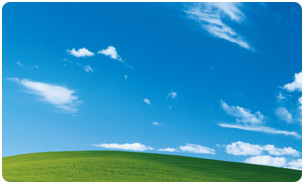
“For oft, when on my couch I lie
In vacant or in pensive mood,
They flash upon that inward eye,
Which is the bliss of solitude;
And then my heart with pleasure fills,
And dances with the daffodils."
In anticipation of reading Anne Friedberg's forthcoming monograph The Virtual Window: From Alberti to Microsoft, I've been considering the connections/differences between older and newer visual virtual frames (which, as I've said before, was one of the central impetuses for starting this blog in the first place, because it aids me in historicising the concept of film-induced tourism). My most recent thoughts relate the computer screen, the Picturesque and tourism into a particular line of flight. This has come about largely due to talks with friends and my new job. Lately, I've been doing some casual office work for a digital imaging company, and in-between tasks - more vacantly than pensively! - I often find myself sitting in front of my PC staring at its standard desktop wallpaper "Bliss" (for Microsoft Windows XP), which shows serene green hills, a deep blue sky and fluffy white clouds. The hill in the foreground is dappled with cloud shadow and what you can't see in the detail of the image (above) are the tiny daffodils dotted in the foreground and some distant purple mountains in the background. This type of imagery (and the colour scheming of green and blue) is very typical for Microsoft, of course, tying in with that 1990s new media aesthetic of freedom, en plein air, travel and open-mindedness - where would you like to go to today?- that Tom Frank has written so clearly about before.
With my thesis topic in mind, the other day a friend was talking to me about the tourism potential of the "Bliss" landscape - he had heard that this image was now a sought-after tourism destination. I tried to research this tip, but unfortunately I couldn't find very much information about it at all, I couldn't even establish whether the photo is real, hyper-real, or a composite of the two... The most I could find on a real-life Bliss location was Microsoft's New Zealand webpage offering their own rather cute "Kiwi-style" variants of Bliss available to download, using an image of a hill from North Otago dotted with sheep (in the winter shot, the sheep are wearing scarves).

So, no real "film tourism" link, but it's made me think about the prominence of the Picturesque in tourism more generally. Bliss is literally taken right out of Wordsworth (so the visual answer to Where would you like to go to today? is I wandered lonely as a cloud...). Wordsworth's site of inspiration was, of course, the Lake District in Northern England that remains a Pictureseque tourism destination (and a literary tourism one), photographed time and time again in very similar ways. I was delighted to find that one person on a personal homepage accompanied by numerous blissful photographs of the region even makes a reference t0 my blogsake, the Claude Glass:
"The north top is still rough and trackless but it is well worth the extra effort to visit this superb vantage point. I have accumulated a fair bit of evidence of historic access to this hill. Apparently it was one of the seven 'stations' around Derwentwater which were visited by Victorian tourists. It was the custom to turn one's back on the scene and view it through a convex mirror, a Claude Glass, to better appreciate its artistic qualities."

7 comments:
I'd go a bit further and argue that UNTIL digital cameras equipped with nice LCD screens became common, the original promise of photography hadn't really been fulfilled. The impetus to "fix the image" helped to create the photograhic process, but it was anything but quick, easy, or manageable while on a trip. Today's digital devices allow one to not only fix the image, but to hold it, review it, and share it across the world. Check out my fall 2005 project at www.re-picture.info.
...great minds think alike
cheers
Darryl Baird
Well done!
[url=http://qaohfsuz.com/tuqb/cuua.html]My homepage[/url] | [url=http://tcvhqfce.com/pseh/xgzy.html]Cool site[/url]
Well done!
My homepage | Please visit
Good design!
http://qaohfsuz.com/tuqb/cuua.html | http://ribrthwf.com/xzrg/fsqm.html
This purports to answer your question about the location of the bliss image
http://en.wikipedia.org/wiki/Bliss_%28image%29
female picture rate
Excellent, love it! discount meridia Before after rhinoplasty lasik eye surgery Aftermath prozac zoloft luvox fen phen Extreme weight loss due to concerta Card+compact+flash+lan+wireless Face mapping acne 1955 chevy convertible for sale Illinois breast enhancement tips refrigerators ge Pain relief endometriosis face lift oxygen Peugeot 605 fuel injection oral surgery recipes car seat covers for dogs http://www.compare-pilates-reformer-and-performer.info Acyclovir desk physician reference
Post a Comment